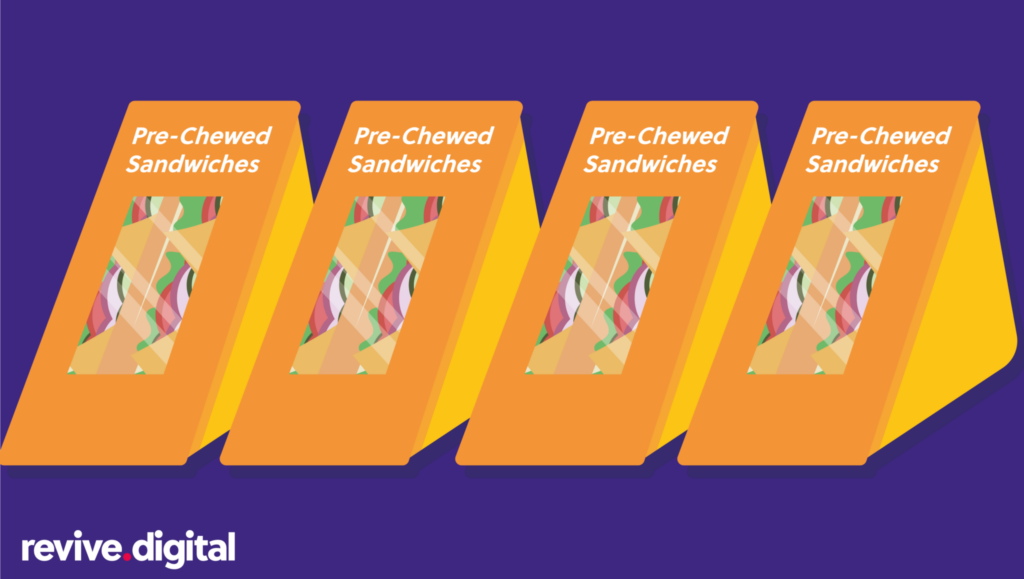Leveraging User Generated Content
Let’s say you’ve gone to Revive Animal Sanctuary. You’ve ‘snapped’ a picture of the alligators, posted it on Instagram and tagged the sanctuary @reviveanimals. That’s user generated content. When you’re home you leave a review… ‘What a lovely afternoon, beautiful staff, no funny smells in reception, credit to the nation…’ etc etc. That’s user generated content. OK, we don’t really have an animal sanctuary but you get the picture (and will hopefully post it on Facebook leaving a lovely review about the Revive-apotamous). If a message comes from a legitimate consumer, it’s trusted content. It’s seen as more genuine, more authentic. There’s less likely to be the cynicism that comes with a general marketing campaign or advertising.
‘Less than 3 in 10 consumers said they trusted each kind of digital advertising. Targeted ads on social media and sponsored ads on social platforms and websites were viewed with particular scepticism.’
Trustworthiness in advertising: What consumers have to say - Trustpilot
Why Use User Generated Content?
Authenticity, trust, context. That’s why. It’s also often cost effective and scalable. Informative, useful content is always the winner, and you should always be doing that. But it has to be authentic. Proper user generated content is seen as truly authentic. Even if it's negative. Because, don’t forget that if consumers are unhappy, they can create content that shows the bad things too. But people's scepticism of branded messages doesn’t mean you should pull all your digital adverts. That’s not helpful. What UGC does is support all your marketing efforts. Think about your marketing cycle. For argument’s sake we’ll use something simple:  User generated content of all varieties plays an important role in each of these inbound marketing stages. For example, when was the last time you bought a product online you hadn’t bought before without looking at a review? That’s UGC at the Attract, Convert and Close stages. And once someone’s bought the product an existing user who posts regularly showcasing different applications for your product will Delight. But this can be great in the Attract stage too. Content created 'outside the business' can deliver some of your marketing's highest conversion rates. And what’s good is that you can encourage users to create content.
User generated content of all varieties plays an important role in each of these inbound marketing stages. For example, when was the last time you bought a product online you hadn’t bought before without looking at a review? That’s UGC at the Attract, Convert and Close stages. And once someone’s bought the product an existing user who posts regularly showcasing different applications for your product will Delight. But this can be great in the Attract stage too. Content created 'outside the business' can deliver some of your marketing's highest conversion rates. And what’s good is that you can encourage users to create content.
Authenticity
Perhaps this sums up UGC the best. If someone knocks on your door and tries to sell you something, scepticism is probably your first reaction. You grab your chin and think ‘ho hum… what is this person all about?’ People are wary and there are a range of surveys on how and who purchasers trust on social media. But there are definitely online consumer trust issues. Content consumers want content to be authentic, even if it’s paid for. The best creators know this and will say that affiliate links are present in the content. They don’t want an influencer to highlight a pair of joggers simply because they’ve been gifted a pair (although in reality this does happen… and in reality it works.) If a consumer feels they’ve been manipulated or cheated in any way, they’ll probably walk. And maybe tell ten friends. Genuine, user-led content avoids all these problems. Content that’s about you and that you’ve not paid to have created, is considered by audiences as the most authentic of all. What’s more, authentic user generated content builds trust in your brand and therefore in your paid advertising.
People Trust People
It’s long been a thing in marketing that people buy from people. Put pictures of people in your adverts. Put testimonials in your marketing collateral. That reasoning is nothing new. Whereas previously a fan wouldn’t take out a TV ad to show how much they love a particular product. But the digital age means they can do something bigger. Advocates can take to Instagram or YouTube, for example, and say how much they enjoy your product or service. They can show their reaction as they unbox it, they can take a picture of the product or service in action, showing how it’s impacted their life. As Neil Patel puts it: ‘Consumers trust organic, user-generated content more than they trust traditional advertising. In other words, your audience would rather hear from your customers instead of you.’ UGC is most often seen on social media as social proof of how over the moon a consumer is with your service or product.
Puts Your Brand or Product into Context
Old advertising saying: ‘You don’t show the eggs and flour, you show the finished cake…’ … or something like that. The above is paraphrased from memory. But the point is user generated content will often show a person actually using and enjoying your product. They will show it in action solving their problems. It shows the finished cake being scoffed… If it solves one person’s problems or inspires someone else, you can bet your last marketing budget dollars it will do the same for someone else who wants similar results. 

Brand Awareness and Social Proof
How do your potential customers find you? How do the existing ones understand your brand? People discover a lot of brands through search engines, social media posts, customer reviews and a brand’s general online community and presence. Psychologist Robert Cialdini first wrote about the concept of social proof in his book ‘Influence’. Also known as social influence, it’s basically the observation that in certain situations, people copy the actions of others in an attempt to emulate their behaviour. If you’re in a football crowd or if you’re at a black-tie dinner, you will probably begin to chant football songs or speak in more eloquent tones to imitate other people, so you fit in. Or perhaps more accurately so you don’t stand out.
Beats by Dre is a great example of a brand that has huge social kudos attached to it. The brand grew massive on the idea that by wearing Beats you’re part of something, a community that valued sound and sleek looks. It used celebrity endorsements and UGC to create the kind of social proof we're talking about here. And people wanted in.
In 2014 Apple bought Beats for $3 billion.

Posting Photos, Ok… What Are Other Types of UGC?
User Generated Content is nothing new. Posting a photo, leaving a review or testimonial – people have been doing that stuff for decades… … the first online reviews date back to 1999. Testimonials were standard in direct mail and mail order, which dates back to the 1860s (allegedly the first catalogue of products for sale was printed in Venice in 1498). But the digital revolution made everything more accessible and faster. Today your advocates might do any of the following:
-
Post images of your product
-
Create videos and YouTube content such as unboxing or reactions
-
Post social media content (i.e an X or instagram post tagging your brand)
-
Leave testimonials
-
Write product reviews
-
Live streams
-
Write blog posts
If your business sends out a marketing message, it might hit the mark. It might do amazingly well. But it has come from you. And you’re biased. Of course, you believe your pre-chewed sandwich is the best thing since sliced bread. If that message comes from a legitimate (and probably toothless) consumer, the effect is greater. It’s trusted content that’s seen as genuine. There’s less likely to be the cynicism that comes with your brand-created marketing efforts and advertising.  In this way user generated content helps you stand out from competitors in a unique way. And social media lends itself perfectly to UGC. It’s a natural home for communities of advocates. But that doesn’t mean you should only focus on social platforms. Really.
In this way user generated content helps you stand out from competitors in a unique way. And social media lends itself perfectly to UGC. It’s a natural home for communities of advocates. But that doesn’t mean you should only focus on social platforms. Really.
Think about the time and costs involved with in-house content creation. Nurturing your user generated content efforts is cost-effective. In particular, if you focus on the few advocates that create the most engaging content you can scale up fast.
User Generated Content and B2B
We’ve talked a lot about user generated content, but what about in the B2B sphere? Perhaps you’re thinking ‘case studies, check. Testimonials, check. Yes, we do user generated content…’ If consumers treat brand messages with scepticism, what about organic messages from employees? Employee generated content is great for employer branding, i.e how your brand appears to prospective employees. It helps you attract new, and the best, candidates. But brand messages are shared more frequently when organically posted by employees, rather than the business itself. So if you’re encouraging (or even incentivising) employees to share your content it can do wonders for your brand. And don’t overlook professional online communities and forums. Things like these and PR, while not directly classed as UGC, will help your brand stay up front of people’s minds. Do enough, showcase your expertise and you’ll get mentions and effective earned media naturally.
Some Challenges with User Generated Content
There’s no such thing as a free lunch, even if someone else has done all the hard work chewing the sandwiches. And so, there are challenges with user generated content too, the biggest factor being the lack of control you have over what someone else posts.
- The quality of images and videos might not reflect your brand image standards. Because content is sooooo simple to create these days you’ll potentially get lots of it. And lots of it isn’t going to meet your brand standards either.
- If you’re reusing UGC, adding it to a gallery for example, you might need to edit videos or images for quality control purposes, adding time and cost for your team.
- People often prefer privacy and if a person posts anonymously this can be seen as less credible for your brand.

Using Users’ Content
The most important rule… if you’re going to repurpose a piece of content always ask first otherwise you risk the goodwill of your best brand advocates. People use branded hashtags all the time and they may not even know they’re part of any campaign. Also by asking the creator you‘re showing that you value their input. They’ll probably be over-the-moon about it. Always credit the original creator too. Consider tagging them directly and saying whether you’re using their images, words or words and images.
Even if it’s about your product, a creator owns the copyright. If you ask to use it and explain in detail how and where you reduce the risk of any copyright issues.
If You Want to Encourage User Generated Content for Your Brand
From a simple social media request to full-scale campaigns, it’s possible to encourage customers to share. Try asking users to incorporate your brand hashtag, incentivise your review requests and create campaigns where user generated content is the mechanism. Let people know what type of content you want to see. That’s important. And ask every opportunity. Stick a quick request at the bottom of email campaigns. Ask on the printed collaterol that goes out with your product. Then once you start getting the good stuff, promote it. Share it, create an online gallery. Include UGC images on the product page. And don’t forget to set internal goals and work out how you‘ll measure success before you start. Choose metrics such as social follows or organic traffic as a couple of examples.
Final Thoughts
There is no one single way to do user generated content. And as with any form of marketing some ways are better suited and will get a better response than others. User generated content shouldn’t replace your organic marketing and to be successful, your brand needs a blend of all types of marketing. Each supports the other in getting your brand in front of people. But experiment with the different types of user generated content and see which works best for you. If you want help getting off the ground with user generated content, give us a shout. We just ask that you make a video of yourself getting in touch…













